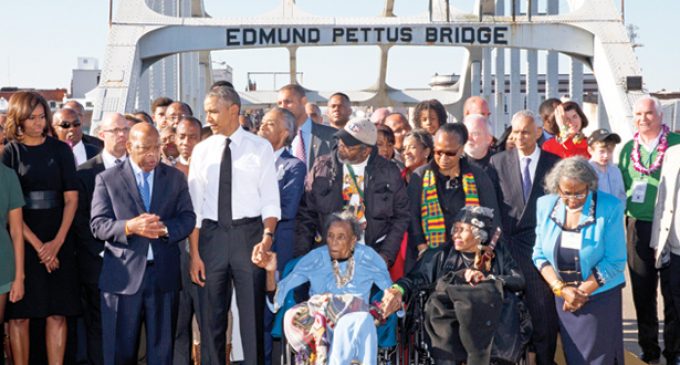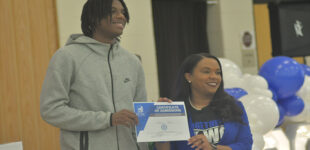Obama marks Selma March milestone

(Above: AP Photo/Jacquelyn Martin- President Barack Obama, fourth from left, listens to Rep. John Lewis, (D-Ga.), as he speaks about “Bloody Sunday” as they and the first family, civil right leaders, and members of Congress, walk across the Edmund Pettus Bridge in Selma, Ala., for the 50th anniversary of the landmark event of the Civil Rights Movement, Saturday, March 7. From left are Sasha Obama, First Lady Michelle Obama, Lewis, Obama, Amelia Boynton Robinson, who was beaten during “Bloody Sunday,” and Adelaide Sanford, also in a wheelchair.)
Butterfield participates in history
By JAY REEVES and DARLENE SUPERVILLE, Associated Press
SELMA, Alabama— America’s racial history “still casts its long shadow upon us,” President Barack Obama said as he stood near the Edmund Pettus Bridge in solidarity and remembrance with civil rights activists whose beatings by police a half-century ago galvanized much of the nation against racial oppression and hastened passage of historic legislation guaranteeing voting rights for minorities.
Tens of thousands of people on Saturday joined to commemorate the “Bloody Sunday” march of 1965 and take stock of the struggle for equality.
One of thousands in attendance was U.S. Rep. G. K. Butterfield of North Carolina’s First District, chairman of the Congressional Black Caucus.
“It was one of the highest honors of my life to join President Obama, President Bush, and dozens of congressional colleagues in commemorating the 50th Anniversary of Bloody Sunday that led to the passage of the Voting Rights Act. As Chair of the Congressional Black Caucus, I had the privilege of sitting in the front section during the ceremonies at the Edmund Pettis Bridge, Alabama State Capital, 16th Street Baptist Church, Brown Chapel AME Church, and First Baptist Church. Butterfield said.
Under a bright sun, the first black U.S. president praised the figures of a civil rights era that he was too young to know but that helped him break the ultimate racial barrier in political history with his ascension to the nation’s highest office. He called them “warriors of justice” who pushed America closer to a more perfect union.
“So much of our turbulent history-the stain of slavery and anguish of civil war, the yoke of segregation and tyranny of Jim Crow, the death of four little girls in Birmingham, and the dream of a Baptist preacher–met on this bridge,” Obama told the crowd before taking a symbolic walk across part of the Edmund Pettus Bridge, the same bridge where the 1965 marchers were attacked by police.
“It was not a clash of armies, but a clash of wills, a contest to determine the meaning of America,”Obama said. He was three years old at the time of the march.
A veteran of that clash, U.S. Rep. John Lewis, who was severely beaten by police that day in 1965 and suffered a skull fracture, exhorted the crowd to press on with the work of racial justice.
“Get out there and push and pull until we redeem the soul of America,” Lewis said. He was the youngest and is the last survivor of the Big Six civil rights activists, a group led by the Rev. Martin Luther King, Jr. that had the greatest impact on the movement.
Among those in attendance was Peggy Wallace Kennedy, daughter of the late George Wallace, the Alabama governor in 1965 who once vowed “segregation forever.”
Selma’s fire department estimated the crowd reached 40,000. Former President George W. Bush shared the platform. Republican congressional leaders were mostly absent but one, House Majority Leader Kevin McCarthy, joined the walk.
The walk progressed under the bold letters on an arch, identifying the bridge named after Pettus, a Confederate general in the Civil War, senator and reputed Ku Klux Klan leader.
Obama, his wife, Michelle, and their two daughters walked about a third of the way across, accompanied by Lewis, who has given fellow lawmakers countless tours of this scene. Bush, his wife, Laura, and scores of others came with them before a larger crowd followed.
Two years after King’s historic “I have a dream” speech in Washington, D.C. the Bloody Sunday march became the first of three aiming to reach Montgomery, Alabama, to demand an end to discrimination against black voters. Scenes of troopers beating marchers on the bridge shocked the nation, emboldening leaders in Washington to pass the Voting Rights Act five months later.
“Our congressional delegation was very diverse consisting of Democrats and Republicans who represent districts across America,” Butterfield said. “We had a unique opportunity to witness recounts of decades of segregation and the denial of the right to vote.
“The Selma story provides compelling reasons why a strong Voting Rights Act is absolutely critical to protecting Americans’ right to vote.”
“I call on my many Republican colleagues who made this journey to join the effort to amend the Voting Rights Act to comply with the United States Supreme Court’s decision by updating the coverage formula.
“It would be unforgivable for my Republican friends to have made this historic journey and then turn their backs on the need to protect the voting rights of African Americans and other racial minority groups.”
On his way to Selma, Obama signed a law awarding the Congressional Gold Medal to participants of the trio of marches, the last of which brought protesters all the way to Montgomery.















